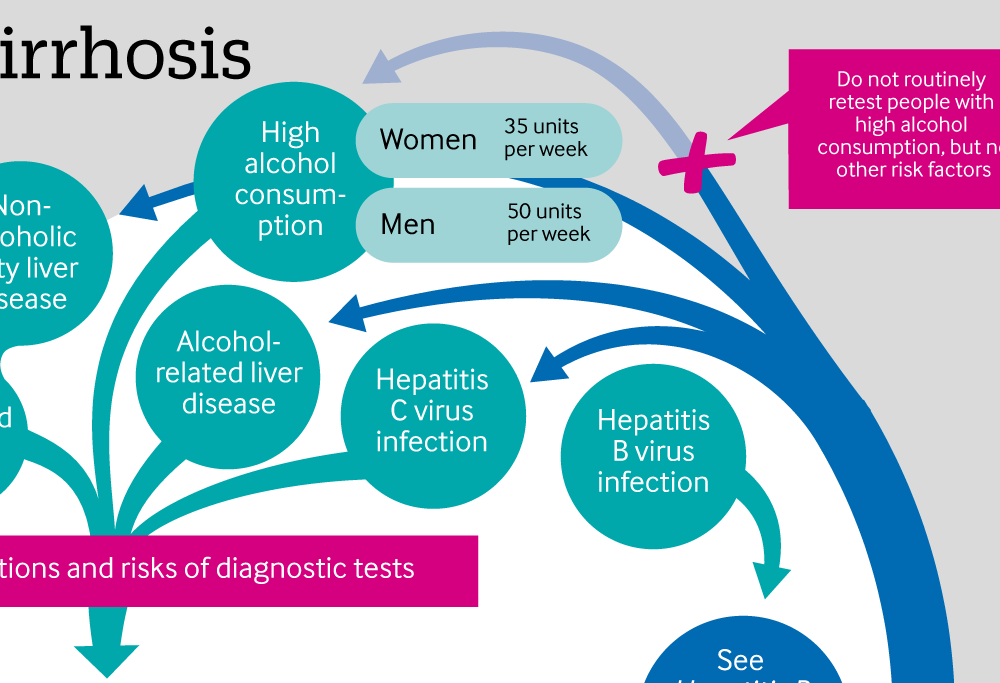Intended for healthcare professionals
Rapid response to:
Practice
Guidelines


Assessment and management of cirrhosis in people older than 16 years: summary of NICE guidance
BMJ 2016; 354 doi: https://doi.org/10.1136/bmj.i2850 (Published 06 July 2016) Cite this as: BMJ 2016;354:i2850
Infographic: Detecting Cirrhosis
A visual summary of tests to offer for patients with different risk factors for cirrhosis, and monitoring strategies depending on diagnostic results

Rapid Response:
Re: Assessment and management of cirrhosis in people older than 16 years: summary of NICE guidance
Liver cirrhosis is becoming one of the major killers and is emerging as a serious public health issue. The article brings to attention the means of assessment and effective management of cirrhosis(1). Recent statistics published by the chief medical officer for England state liver diseases are on the rise in England whereas they are decreasing among other European countries (2). High alcohol consumption, obesity and chronic viral hepatitis B and C are leading contributors to liver cirrhosis worldwide(3).
Fibroscan is still widely used for the early diagnosis of cirrhosis, although other modern non-invasive tools such as acoustic radiation force impulse (ARFI), real-time elastography (RT-E), magnetic resonance elastography (MRE), and shear wave elastography (SWE) are being used as well.(4) Absence of contraindications, easy manageability, time and cost effectiveness and higher safety make fibroscan more acceptable than previously predominantly used liver biopsy. However, readings are unreliable for people presenting conditions such as obesity, ascites, certain metabolic syndromes (type 2 diabetes, increased waist circumference), old age, active hepatitis, biliary obstruction and mass lesions within the liver. Elastography does not replace either conventional ultrasound or liver biopsy. While ultrasound examination provides a panoramic view of the structural integrity of the liver, and features of portal hypertension, liver biopsy is essential for the staging of cirrhosis. Liver biopsy is associated with bleeding, but is rare, recording to only around 0.35%(5).
Apart from patients with refractory ascites, transjugular intrahepatic portosystemic shunt (TIPS) should be also offered to patients suffering from esophageal bleeding, hepatorenal syndrome and portal vein thrombosis(6) as these conditions are also common complications of cirrhosis.
Cirrhotic patients with hepatocellular carcinoma, portopulmonary hypertension should perhaps be considered as exceptional groups (7) as their calculated MELD score doesn’t represent the real severity of the condition and can change unexpectedly over a short period time.
1. P Harrison, BJ Hogan, E Davies “Assessment and management of cirrhosis in people older than 16 years:” summary of NICE guidance .BMJ 2016; 354 doi: http://dx.doi.org/10.1136/bmj.i2850 (Published 06 July 2016) Cite this as: BMJ 2016;354:i2850
2. Department of Health. Chief medical officer publishes her first annual report. 2012. www.dh.gov.uk/health/2012/11/cmo/
3. Rohit Loomba, Hwai-I Yang, Jun Su et al “Synergism Between Obesity and Alcohol in Increasing the Risk of Hepatocellular Carcinoma: A Prospective Cohort Study”. Am. J. Epidemiol. (2013) 177(4):333-342
4. Australian Family Physician. The right upper quadrant, July 2013 “Fibroscan and transient elastography”. Volume 42, No7, July 2013 Pages 468-471
5. Dotan Y, Carlebach M, Zuckerman E, Maruf M, Schiff E “Delayed bleeding after percutaneous liver biopsy.” EJCRIM 2016;3:doi:10.12890/2016_000359
6. Jason T Sasamendi, FranciscoJ Gortes, Michelle Shnayder et al “Transsplenic portal vein reconstruction–transjugular intrahepatic portosystemic shunt in a patient with portal and splenic vein thrombosis”. Radiology case report, ELSEVIR. Available online 21 June 2016
7. Saleh Elwir, John Lake “Current Status of Liver Allocation in the United States” Gastroenterology & Hepatology March 2016, Volume 12, Issue 3
Competing interests: No competing interests